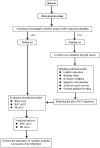Machine learning algorithms to predict the risk of admission to intensive care units in HIV-infected individuals: a single-centre study
- PMID: 40764558
- PMCID: PMC12326867
- DOI: 10.1186/s12985-025-02900-w
Machine learning algorithms to predict the risk of admission to intensive care units in HIV-infected individuals: a single-centre study
Abstract
Antiretroviral therapy (ART) has transformed HIV from a rapidly progressive and fatal disease to a chronic disease with limited impact on life expectancy. However, people living with HIV(PLWHs) faced high critical illness risk due to the increased prevalence of various comorbidities and are admitted to the Intensive Care Unit(ICU). This study aimed to use machine learning to predict ICU admission risk in PLWHs. 1530 HIV patients (199 admitted to ICU) from Beijing Ditan Hospital, Capital Medical University were enrolled in the study. Classification models were built based on logistic regression(LOG), random forest (RF), k-nearest neighbor (KNN), support vector machine (SVM), artificial neural network(ANN), and extreme gradient boosting(XGB). The risk of ICU admission was predicted using the Brier score, area under the receiver operating characteristic curve (ROC-AUC), and area under the precision-recall curve(PR-ROC) for internal validation and ranked by Shapley plot. The ANN model performed best in internal validation (Brier score = 0.034, ROC-AUC = 0.961, PR-AUC = 0.895) to predict the risk of ICU admission for PLWHs. 11 important features were identified to predict predict ICU admission risk by the Shapley plot: respiratory failure, multiple opportunistic infections in the respiratory system, AIDS defining cancers, baseline viral load, PCP, baseline CD4 cell count, and unexplained infections. An intelligent healthcare prediction system could be developed based on the medical records of PLWHs, and the ANN model performed best in effectively predicting the risk of ICU admission, which helped physicians make timely clinical interventions, alleviate patients suffering, and reduce healthcare cost.
Keywords: Admission; Artificial neural network (ANN); HIV; HIV-related comorbidities; ICU; Machine learning; Predictive modeling; Risk factors; SHAP analysis.
© 2025. The Author(s).
Conflict of interest statement
Declarations. Ethics approval and consent to participate: The study involving human participants was reviewed and approved by Human Science Ethical Committee of Beijing Ditan Hospital, Capital Medical University. Written informed consent for participation was not required for this study in accordance with the institutional requirements due to a retrospective study. Consent for publication: Not applicable. Competing interests: The authors declare no competing interests.
Figures




Similar articles
-
Supervised Machine Learning Models for Predicting Sepsis-Associated Liver Injury in Patients With Sepsis: Development and Validation Study Based on a Multicenter Cohort Study.J Med Internet Res. 2025 May 26;27:e66733. doi: 10.2196/66733. J Med Internet Res. 2025. PMID: 40418571 Free PMC article.
-
Development and external validation of machine learning models for the early prediction of malnutrition in critically ill patients: a prospective observational study.BMC Med Inform Decis Mak. 2025 Jul 3;25(1):248. doi: 10.1186/s12911-025-03082-9. BMC Med Inform Decis Mak. 2025. PMID: 40611154 Free PMC article.
-
Machine learning algorithms to predict the risk of hyperlipidemia in people with HIV after starting HAART for 6 months.AIDS. 2025 Sep 1;39(11):1536-1544. doi: 10.1097/QAD.0000000000004244. Epub 2025 May 21. AIDS. 2025. PMID: 40396199 Free PMC article.
-
[Volume and health outcomes: evidence from systematic reviews and from evaluation of Italian hospital data].Epidemiol Prev. 2013 Mar-Jun;37(2-3 Suppl 2):1-100. Epidemiol Prev. 2013. PMID: 23851286 Italian.
-
Using nursing data for machine learning-based prediction modeling in intensive care units: A scoping review.Int J Nurs Stud. 2025 Sep;169:105133. doi: 10.1016/j.ijnurstu.2025.105133. Epub 2025 Jun 7. Int J Nurs Stud. 2025. PMID: 40544524
References
-
- World Health Organization. Global HIV and AIDS statistics. 2023. http://www.unaids.org
MeSH terms
Grants and funding
LinkOut - more resources
Full Text Sources
Medical
Research Materials

